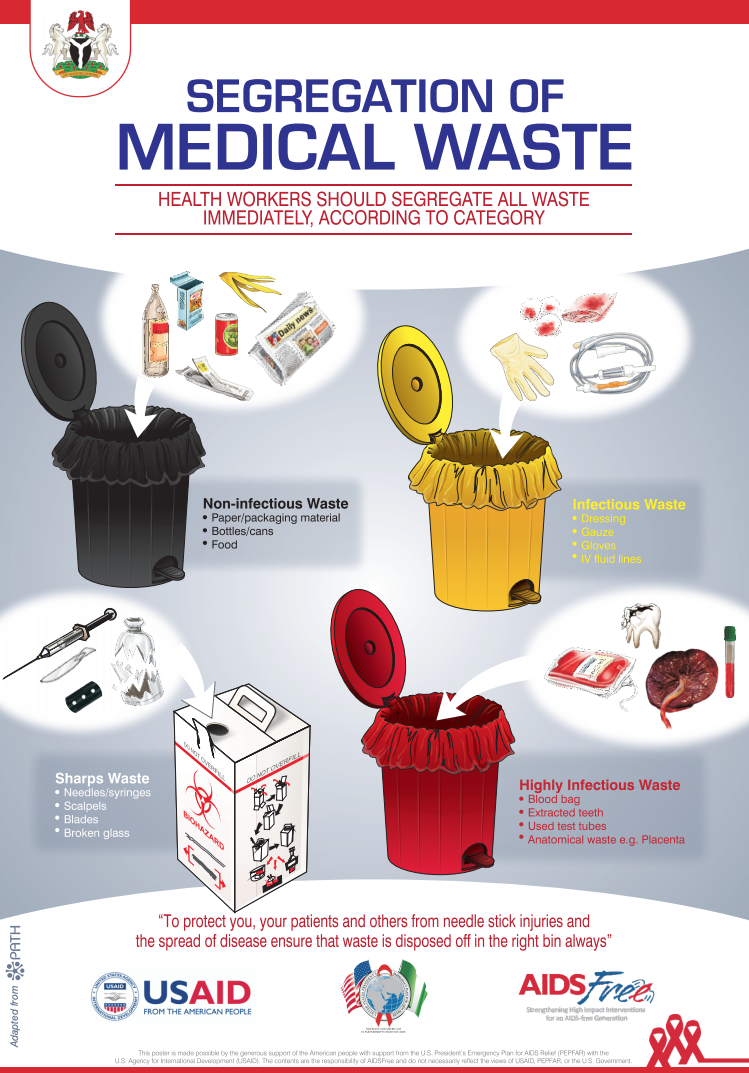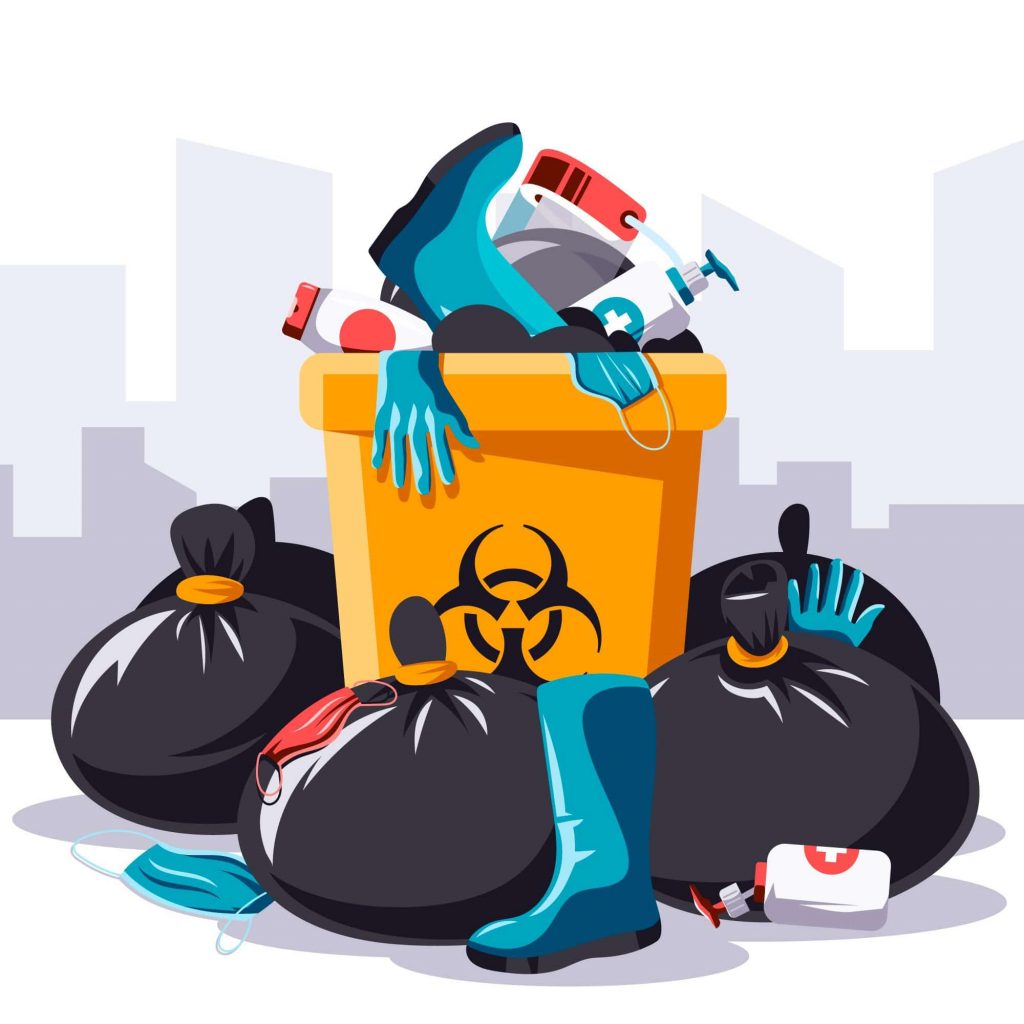Best Practices for Medical Waste Administration
Medical waste administration is an essential facet of health care centers' operations to make sure the safety and security of clients, team, and the environment. Carrying out best methods in clinical waste monitoring is vital to minimize the threats related to contaminated materials. This includes appropriate partition and classification of waste, guaranteeing its safe storage and labeling, adhering to regulative standards, and using efficient disposal approaches. By adhering to these best methods, health care centers can reduce the capacity for infections, injuries, and air pollution triggered by improper handling and disposal of medical waste. This intro intends to provide a review of the importance of finest techniques for medical waste management and the succeeding sections will certainly explore each technique thoroughly - medical waste disposal.

Segregation and Classification
In the area of clinical waste administration, appropriate segregation and categorization are important methods for ensuring the secure and effective disposal of healthcare-related products. Medical waste is created from different resources, consisting of hospitals, centers, research laboratories, and other healthcare centers. It contains a large variety of things, such as needles, syringes, plasters, gloves, and pharmaceutical waste.
Partition entails the methodical splitting up of various kinds of clinical waste based upon their characteristics and prospective risks. This procedure helps to avoid cross-contamination and makes certain that each kind of waste is handled properly. For example, sharps waste, such as needles and blades, need to be positioned in puncture-resistant containers to stop injuries and the spread of infectious illness. Transmittable waste, such as blood-soaked bandages or cultures, must be set apart and treated individually to lessen the risk of spreading virus.
Classification is the process of classifying clinical waste right into various groups based upon its potential dangers. These classifications may consist of infectious waste, contaminated materials, pharmaceutical waste, and basic waste. By classifying waste, healthcare centers can determine the proper disposal approaches and make certain conformity with local policies and standards.
Correct segregation and categorization of medical waste not only protect the health and safety and security of medical care workers and the public yet likewise contribute to the total effectiveness and efficiency of waste monitoring. It decreases the danger of crashes, decreases ecological influences, and advertises responsible waste disposal techniques.
Correct Storage Space and Classifying
To make certain the effective and risk-free disposal of clinical waste, healthcare centers should follow appropriate storage space and labeling techniques. WasteX Medical Waste Disposal. Proper storage space and labeling play a critical function in maintaining the honesty of clinical waste administration systems and safeguarding the health and wellness of medical care workers, patients, and the public
When it pertains to storage, it is vital to have actually marked locations especially made for different kinds of clinical waste. These areas must be safe and secure, well-ventilated, and geared up with proper containers that satisfy regulative criteria (medical waste removal service). Partition and categorization of waste must also be thought about to avoid cross-contamination and potential threats

Normal surveillance and evaluation of storage locations and containers are necessary to identify any kind of concerns or offenses. Staff must be educated on proper storage and labeling practices, emphasizing the significance of conformity with procedures and laws.
Safe Transportation and Handling
Making sure the proper and safe transport and handling of clinical waste is essential for keeping the honesty of waste monitoring systems and protecting the health and wellness of all entailed. Medical waste, which consists of products infected with transmittable materials, drugs, and other dangerous compounds, have to be moved in a fashion that avoids leaks, spills, and potential contamination.
It is necessary to use leak-proof and puncture-resistant containers that are particularly made for medical waste. Additionally, waste must be set apart based on its nature and type to prevent cross-contamination.
Throughout transport, it is necessary to make sure that waste containers are securely secured and saved in a stable fashion. Automobiles utilized for delivering medical waste ought to be outfitted with ideal safety features, such as spill control systems, to reduce the danger of any kind of spills or leakages. Vehicle drivers need to obtain training on correct handling and emergency situation feedback treatments to successfully resolve any kind of unforeseen incidents.
Furthermore, the transport and handling of clinical waste need to abide with all pertinent laws and standards stated by neighborhood, state, and federal authorities. WasteX Medical Waste Disposal. medical waste removal. Normal inspections and audits need to be performed to examine compliance and identify any kind of locations for enhancement
Conformity With Regulatory Standards
Keeping conformity with regulative standards is crucial for efficient medical waste administration. These guidelines are established to protect public wellness and the environment by making sure that clinical waste is appropriately dealt with, dealt with, and disposed of. Compliance with regulative standards assists to avoid the spread of infectious conditions, lessen prospective risks, and lower the total influence of medical waste on the environment.
To attain conformity, healthcare centers should stay educated regarding the specific guidelines controling medical waste management in their territory. These policies may differ from nation to nation, and also within different states or regions. It is necessary for medical care facilities to have a detailed understanding of these standards and to apply ideal approaches and protocols to ensure compliance.
One secret aspect of conformity is the proper segregation and labeling of different kinds of medical waste. This includes separating sharps from various other waste, as well as categorizing waste based upon its prospective dangers. Health care facilities must also ensure that medical waste is stored in proper containers and that these containers are correctly labeled and sealed.
Furthermore, compliance with regulatory standards calls for medical care centers to develop correct training and education programs for team member entailed in medical waste management. This includes providing training on waste partition, handling, and disposal treatments, in addition to the appropriate use personal safety tools.
Routine tracking and audits are likewise vital to make sure continuous compliance with regulative guidelines. This entails performing routine evaluations of waste storage locations, documenting waste management treatments, and keeping documents of garbage disposal.
Efficient Disposal Techniques
Health care facilities need to use effective disposal techniques for proper administration of medical waste. Inappropriate disposal of clinical waste can present major health and environmental dangers. There are several approaches that can be made use of to properly deal with clinical waste, making sure the safety of health care workers, individuals, and the public.
One generally made use of approach is incineration. Incinerators can safely shed medical waste at high temperatures, decreasing the quantity and damaging any type of possibly unsafe pathogens. Incineration can be expensive and may release unsafe toxins into the air if not properly regulated.
An additional technique is autoclaving, which entails subjecting the waste to high-pressure heavy steam. This procedure eliminates bacteria, infections, and various other microorganisms, making the waste secure for disposal in regular waste streams. Autoclaving is a environmentally friendly and efficient approach, but it requires specific equipment and skilled employees.
Chemical sanitation is also utilized sometimes, where fluid chemicals are applied to the waste to disinfect it. This technique is much less commonly used go because of concerns about the efficiency of chemical sanitation and the potential for chemical residues to infect the atmosphere.
Along with these approaches, medical care facilities need to likewise apply proper segregation, product packaging, and labeling of medical waste to guarantee its safe handling and disposal. Regular training and education of staff on proper waste management practices are vital to keeping efficient disposal methods.
Verdict
To conclude, implementing ideal practices for medical waste management is important for making sure the safety of healthcare employees, patients, and the environment. By properly setting apart and classifying waste, keeping and identifying it correctly, ensuring secure transport and handling, following regulative guidelines, and employing effective disposal methods, medical care facilities can properly handle and lessen the risks associated with clinical waste. It is critical for health care organizations to focus on and adhere to these ideal methods to maintain a lasting and risk-free healthcare environment.
Clinical waste monitoring is a crucial facet of medical care centers' procedures to make certain the security of patients, staff, and the setting. Implementing best methods in medical waste monitoring is essential to reduce the threats connected with unsafe waste. These classifications might include infectious waste, hazardous waste, pharmaceutical waste, and basic waste.In conclusion, applying best methods for clinical waste monitoring is vital for ensuring the security of healthcare workers, people, and the environment. By appropriately segregating and categorizing waste, storing and identifying it correctly, making sure secure transportation and handling, abiding with regulatory standards, and employing reliable disposal approaches, healthcare facilities can successfully take care of and minimize the risks connected with clinical waste.